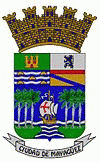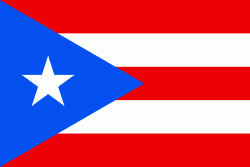Mayagüez (Mayagüez Municipio)
 |
The Mayagüez Metro Area (and part of Añasco) lies today on two former Taíno Cacicazgos (chiefdoms): Yaguex and Yagüeca, a region noted for its record of colonial resistance (i.e., Urayoán and Legend of Diego Salcedo). The Tainos constituted the majority of the island's inhabitants at the time of contact with Europeans in 1493 and called it Borikén or Borinquen. Today, this appellation and its variations continue to designate the Island of Puerto Rico and its people. The Taínos came from South American branches of Arawakan speakers, more specifically from modern-day Venezuela, and lived in small villages, organized their society in clans and named their chiefs Cacique. They were farmers who domesticated crops as pineapples, cassava, and sweet potatoes supplemented by fish and seafood.
Mayagüez was founded on September 18, 1760, by a group led by brothers Faustino and Lorenzo Martínez de Matos, Juan de Silva and Juan de Aponte, at a hill located about one kilometer inland from Mayagüez Bay and the outlet of the Yagüez River. The Spanish Crown granted the founders the right to self-government in 1763, formally separating the town from the larger Partido de San Germán. The settlement was named Nuestra Señora de la Candelaria de Mayagüez (Our Lady of Candelaria of Mayagüez) to evoke an apparition of the Virgin Mary on the island of Tenerife, one of the Canary Islands. Most of the town's settlers, including its founders, migrated from the archipelago, whose patron saint is the Virgin of Candelaria. On May 7, 1836, the settlement was elevated to the royal status of villa, and Rafael Mangual was named its first mayor. At the time, the villa's principal economic activity was agriculture. The famous patriot, educator, sociologist, philosopher, essayist and novelist Eugenio María de Hostos was born in Mayagüez in 1839. On July 10, 1877, the villa received its city charter from the Royal Crown of Spain.
Puerto Rico was ceded by Spain in the aftermath of the Spanish–American War under the terms of the Treaty of Paris of 1898 and became a territory of the United States.In 1899, the United States Department of War conducted a census of Puerto Rico finding that the population of Mayagüez was 35,700, making it one of the largest towns in Puerto Rico at the time.
The city's main Roman Catholic church, Our Lady of the Candelaria, was built in a plot consecrated on August 21, 1760. Its first masonry building was erected in 1780. The current church was built in 1836, and was rebuilt in 1922. The redesign by architect Luis Perocier sought to restore the building to its original splendor. The 1918 San Fermín earthquake had destroyed the temple's ceiling, and a lightning bolt struck and tore down a wedge-shaped corner of one of its two bell towers. However, lack of proper funding and the extent of the damage of the original structure forced the rebuilding to be scaled-down considerably.
In 1911, the College of Agriculture and Mechanic Arts was founded in Mayagüez. Today it is known as the University of Puerto Rico at Mayagüez (UPRM)—the Caribbean's leading engineering institution. Between 1962 and 1998 Mayagüez was a major tuna canning and processing center. At one time, 80% of all tuna products consumed in the United States were packed in Mayagüez (the biggest employer, StarKist, had 11,000 employees working three daily shifts in the local plant's heyday). Mayagüez was also a major textile industry hub; almost a quarter of all drill uniforms used by the United States Army were sewn in the city. Today, Mayagüez is the fifth-largest city in Puerto Rico and is considered one of the most important cities in the island. The city is centered on the impressive Spanish-style main square Plaza Colón, a tribute to Christopher Columbus, whose statue stands in the middle of the square, surrounded by 16 bronze statues.
Mayagüez has become a major college town with the establishment of the UPRM, the now closed Eugenio María de Hostos Law School and the Pontifical Catholic University of Puerto Rico.
On September 20, 2017 Hurricane Maria struck Puerto Rico. In Mayagüez, losses were described as "catastrophic". The storm triggered numerous landslides in Mayagüez. In some areas of Mayagüez, there were over 25 landslides per square mile due to the deluge.
Map - Mayagüez (Mayagüez Municipio)
Map
Country - Puerto Rico
 |
 |
Currency / Language
| ISO | Currency | Symbol | Significant figures |
|---|---|---|---|
| USD | United States dollar | $ | 2 |
| ISO | Language |
|---|---|
| EN | English language |
| ES | Spanish language |















